Dan inilah langkah yang harus anda ambil untuk memasang fungsi terbilang ini di Microsoft Access:
- Buka Microsoft Access dulu (ya pastilah hehehe…)
- Klik tab Modules, lalu buatlah satu module baru atau anda bisa memasukan script terbilang ini ke dalam module yang sudah ada. Untuk membuat module baru, klik tombol New di tab Modules.
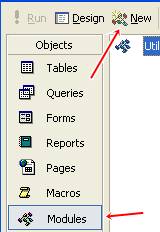
- Lalu copy-paste script dibawah ini ke dalam module baru anda atau anda bisa mengunduh script tersebut dalam bentuk teks, ketik script tersebut pada Microsoft Visual Basic for Application Editor yang sedang terbuka.
Public Function ubah_terbilang(xbil As Double)
Dim nilai, i, j, k, hasil$, HasilAkhir$, Bilangan#, Digit, Rp$, Bil$
If IsNull(xbil) Then
ubah_terbilang = Null
Exit Function
End If
'pengelompokan
Dim Kel$(1 To 6), Angka$(1 To 9), Sat$(1 To 3)
Kel$(1) = "Biliun "
Kel$(2) = "Triliun "
Kel$(3) = "Miliar "
Kel$(4) = "Juta "
Kel$(5) = "Ribu "
Kel$(6) = ""
'data angka
Angka$(1) = "Satu "
Angka$(2) = "Dua "
Angka$(3) = "Tiga "
Angka$(4) = "Empat "
Angka$(5) = "Lima "
Angka$(6) = "Enam "
Angka$(7) = "Tujuh "
Angka$(8) = "Delapan "
Angka$(9) = "Sembilan "
'satuan
Sat$(1) = "Ratus "
Sat$(2) = "Puluh "
Sat$(3) = ""
'mulai
Bilangan# = Val(xbil)
HasilAkhir$ = ""
GoSub HitungHuruf
If hasil$ <> "" Then
HasilAkhir$ = hasil$ + "Rupiah"
End If
'hitung pecahan
Bilangan# = Fix((Bilangan# - Fix(Bilangan#) + 0.005) * 100#)
If Bilangan# > 0 Then
GoSub HitungHuruf
If hasil$ <> "" Then
HasilAkhir$ = HasilAkhir$ + " " + hasil$ + "Sen"
End If
End If
ubah_terbilang = HasilAkhir$
Exit Function
HitungHuruf:
Rp$ = Right$(String$(18, "0") + LTrim$(Str$(Fix(Bilangan#))), 18)
hasil$ = ""
If Val(Rp$) = 0 Then Return
'blg bulat
For i = 1 To 6
Bil$ = Mid$(Rp$, i * 3 - 2, 3)
If Val(Bil$) = 1 And i = 5 Then
hasil$ = hasil$ + "Seribu "
ElseIf Val(Bil$) <> 0 Then
For j = 1 To 3
Digit = Val(Mid$(Bil$, j, 1))
If j = 2 And Right$(Bil$, 2) = "10" Then
hasil$ = hasil$ + "Sepuluh "
Exit For
ElseIf j = 2 And Right$(Bil$, 2) = "11" Then
hasil$ = hasil$ + "Sebelas "
Exit For
ElseIf j = 2 And Mid$(Bil$, 2, 1) = "1" Then
hasil$ = hasil$ + Angka$(Val(Right$(Bil$, 1))) + "Belas "
Exit For
ElseIf Digit = 1 And j = 1 Then
hasil$ = hasil$ + "Seratus "
ElseIf Digit <> 0 Then
hasil$ = hasil$ + Angka$(Digit) + Sat$(j)
End If
Next
hasil$ = hasil$ + Kel$(i)
End If
Next
Return
End Function
- Lalu tutup jendela VBA editor.
- Nah sekarang tinggal mencoba fungsi ini.
Ada dua cara untuk mencoba fungsi ini di Microsoft Access, melalui Form atau Report. Nah, kita akan mencoba yang pertama yaitu melalui Form:
- Buat form baru dengan cara klik tab Forms lalu klik tombol New.
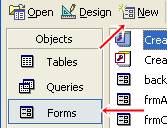
- Di form yang baru tersebut, buat 2 textbox baru. Secara default, maka textbox pertama akan dinamai Text0 dan teks kedua dinamai dengan Text2, anda bisa merubahnya sendiri tetapi dalam contoh ini saya menganggap kita akan memakai nama default yang diberikan.
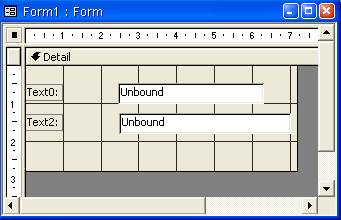
- Lalu buka Microsoft Visual Basic Editor dengan klik menu View -> Code.
- Pilih control Text0 yang akan kita tangkap eventnya.

- Lalu ubah event yang akan di tangkap ke Change.

- Lalu ketikan script:
Text2.Value = ubah_terbilang(Text0.Text)di dalam blokPrivate Sub Text0_Change().
- Tutup jendela Microsoft Visual Basic editor-nya.
- Ubah view form ke Form View.
- Lalu coba ketikan angka di Text0, kalau anda melakukannya dengan benar maka hasilnya akan muncul di Text2.
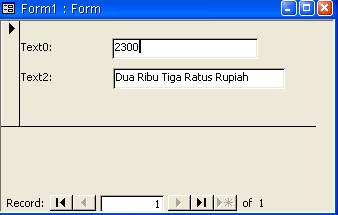
Nah, dari contoh sederhana diatas anda dapat mengembangkannya sendiri menjadi aplikasi yang lebih baik. Untuk implementasi kedua adalah pada Report, penggunaannya sebagai berikut:
- Buat report baru dengan klik tab Reports lalu klik New.
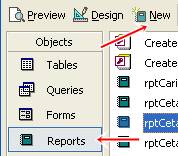
- Setelah semua di buat, dan misalnya anda ingin mengimplementasikan fungsi terbilang (yang diwakili pada textbox txtTerbilang) ini untuk total transaksi yang tercantum di control txtTOTAL, anda tinggal mengetikan
=ubah_terbilang([txtTOTAL].[Value])di Control Source dari txtTerbilang.
- Sekarang tinggal coba membuka report tersebut, kalau anda melakukannya dengan benar maka ‘penampakannya’ akan seperti gambar yang saya pasang sebagai logo artikel ini diatas.
Semoga artikel ini dapat sedikit membantu bagi rekan-rekan yang sedang mencari fungsi terbilang ini untuk proyek Microsoft Access anda.













No response to “Fungsi Terbilang Di Microsoft Access”
Leave a reply